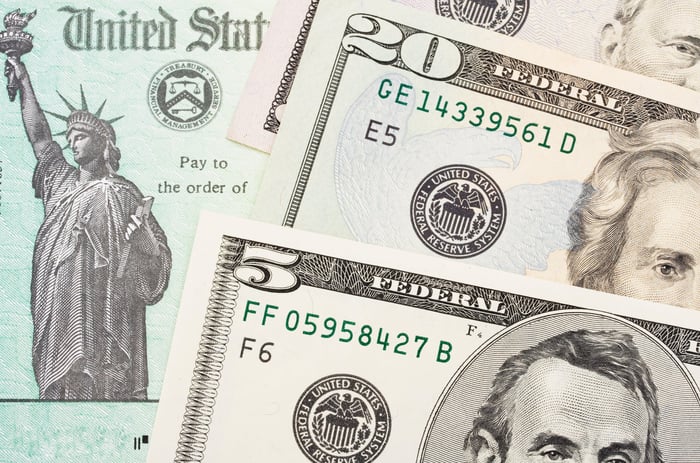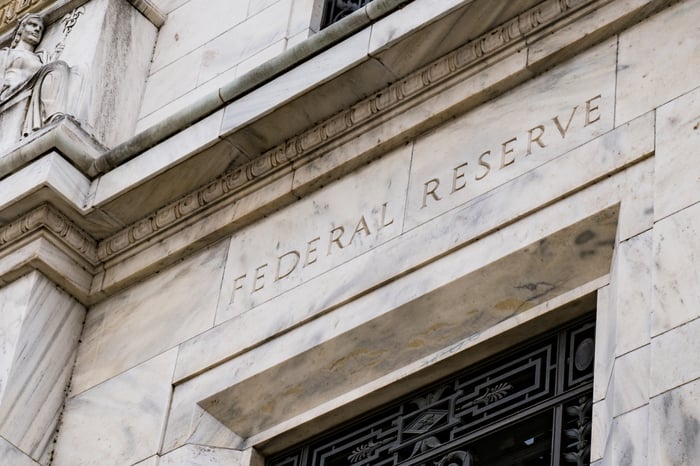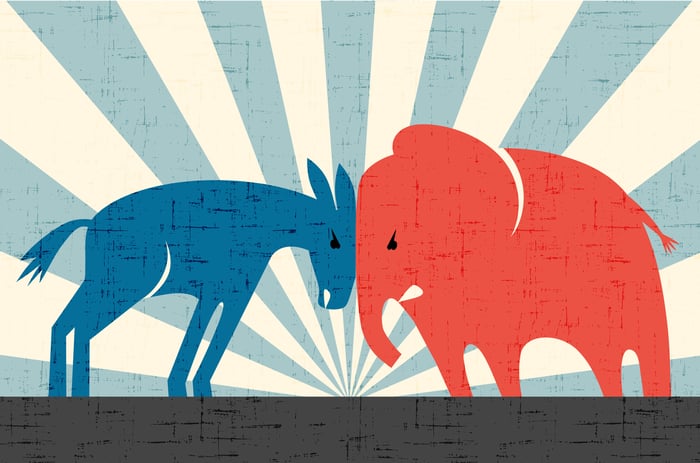Though you might not know it by looking at Wall Street, the coronavirus disease 2019 (COVID-19) pandemic is the largest shock to the U.S. economy since the Great Depression, 90 years ago.
In an attempt to limit disease transmission, most governors were left with little choice other than to shut down nonessential businesses in March. This ultimately led to more than 40 million people filing an initial unemployment claim, and has pushed the unemployment rate from a roughly 50-year low of 3.5% to 13.3% in a matter of months.

Image source: Getty Images.
The CARES Act threw a lot of money at an unprecedented problem
Given the severity of the financial shock that many workers and their families were contending with as a result of these mandated shutdowns, Congress passed and President Trump signed the Coronavirus Aid, Relief, and Economic Security (CARES) Act into law on March 27. At $2.2 trillion, the CARES Act stands head and shoulders above all other relief packages in terms of cost.
In total, $500 billion was apportioned to aid distressed industries, such as the airlines, with nearly $350 billion used for small business loans. The unemployment program was also expanded to include $600-per-week added payouts to eligible beneficiaries through July 31, 2020, at a cost of $260 billion.
But there's no denying that the CARES Act will be most remembered for the $300 billion in direct payments to workers, their families, and senior citizens. To date, the Internal Revenue Service has sent out 159 million Economic Impact Payments (as these payouts are officially known) totaling more than $267 billion.
At their maximum, Economic Impact Payments totaled $1,200 per individual or $2,400 for a couple filing jointly. Further, an extra $500 was added to what a parent or household received for every qualifying dependent child under the age of 17. To net this maximum payout, a single, married, or head-of-household filer would need to have an adjusted gross income (AGI) below $75,000, $150,000, and $112,500, respectively.
Given the many uncertainties tied to the COVID-19 pandemic, as well as the unprecedented nature of the response, throwing a record amount of stimulus at the problem seemed prudent. Unfortunately, polling shows that around three-quarters of stimulus recipients couldn't even cover their expenses for a month, based on what they received. This would suggest a very real need for a second round of stimulus.

Image source: Getty Images.
New data fuels the argument for a new round of stimulus payments
The question is, with the unemployment rate falling in May and states reopening for business, should a second stimulus check really be on the table? Based on new projections provided by the Federal Reserve this past week, the answer to this question looks to be a decisive yes.
Generally speaking, when the Federal Reserve holds one of its Open Market Committee meetings, the focus is on whether or not interest rates will change. With rates already at a record-tying low range of 0% to 0.25%, this wasn't the focus this time around. Rather, economists were honed in on the language the Federal Reserve and Chairman Jerome Powell would use with regard to the intermediate-term outlook for the U.S. economy.
The first notable tidbit of information that raised eyebrows was the expectation that interest rates would remain at record-low levels through 2022. The Fed keeps rates low when it wants to encourage lending and business expansion. The fact that we could see almost three years of record-low rates suggests a slow slog from the economy's trough, rather than a V-shaped bounce back.
But the data that should really stoke the call for a second stimulus check is the Fed's unemployment forecast. By year's end, the Fed is predicting that 15 million people will remain unemployed, which works out to an unemployment rate of 9.3%. That's nearly at the height of the unemployment rate during the Great Recession, and it's going to take the U.S. another seven months just to get down to that point.
What's blatantly clear from this week's Fed meeting is that the U.S. economy is going to take a long time to recover, and those who are unemployed may well need financial assistance sooner rather than later.

Image source: Getty Images.
A final round of stimulus appears likely, but political differences remain
Another unique factor that makes a second round of direct stimulus payments likelier is the fact that we're in an election year. Neither Democrats nor Republicans want to be the party that fails to go to bat for the American public during the worst economic downturn in nine decades.
The biggest hurdle in passing a second round of direct stimulus is going to be overcoming the political divide between the Democrat-led House and the Republican-led Senate.
The House not only wants another round of direct stimulus payouts, but Democrats have proposed sweeping increases in payouts and overall eligibility. In mid-May, the House passed the Health and Economic Recovery Omnibus Emergency Solutions (HEROES) Act, which totaled a jaw-dropping $3 trillion. It would apportion $1 trillion to aid states, extend the unemployment benefits program expansion (i.e., the extra $600 per week) through January 2021, and send another round of direct stimulus to working Americans, their families, and seniors.
Though the HEROES Act utilizes the same AGI eligibility thresholds as the CARES Act, there's a big difference -- namely, dependents (limited to three) add $1,200 to what a parent or household receives, rather than the $500 available through the CARES Act, with dependents of all ages qualifying.
Meanwhile, Republican lawmakers -- and more specifically President Trump -- have touted the idea of a payroll tax holiday. Working Americans pay 12.4% of their earned income (up to $137,700 in 2020) into the Social Security program each year -- or 6.2% if you're employed by a company or someone else. Under the most popular GOP stimulus proposal, this payroll tax would be reduced or eliminated for a specified period of time, thereby increasing what workers would receive in their paychecks.

Image source: Getty Images.
The issue? For Democrats, it's that the GOP's proposal fails to help the unemployed. Additionally, reducing or eliminating the payroll tax could further weaken Social Security, given that payroll taxes accounted for 89% of the $1.06 trillion in revenue collected last year.
As for Republicans, they're staunchly against the idea of extending the $600/week in unemployment benefits through January, as it's viewed as discouraging the restart of the U.S. economy. They're also taken back by the $3 trillion price tag for the HEROES Act and calls for $1 trillion to be sent to individual states.
While I stand by my prediction that another round of stimulus is coming, it may not be immediate. Once the expansion of the unemployment benefits program ends on July 31, 2020, expect the two sides to really begin to discuss what the next phase of stimulus will look like.






